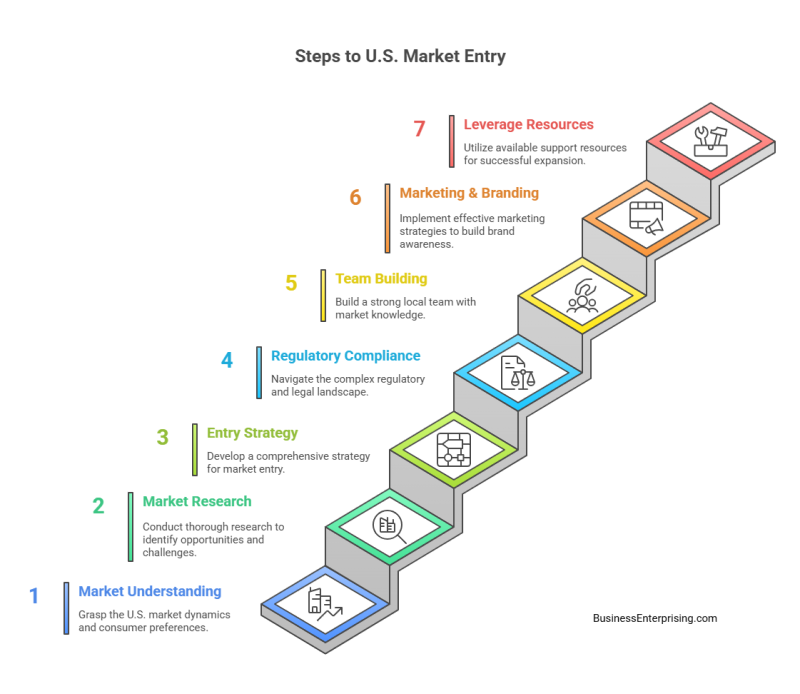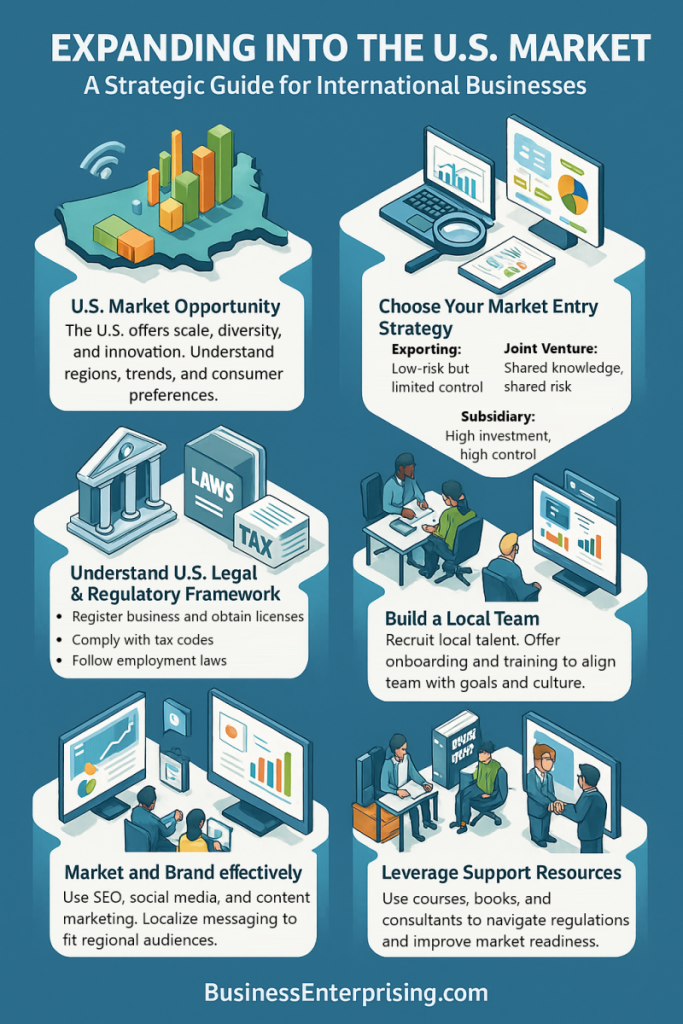
Understanding the U.S. Market
Firstly, it is essential to understand the dynamics of the U.S. market. With a population of over 330 million and a GDP exceeding $21 trillion, the U.S. represents a substantial market opportunity. Moreover, the country’s diverse demographics and consumer preferences create opportunities across various sectors, from technology and healthcare to retail and manufacturing.
Additionally, the U.S. market is characterized by its competitiveness and innovation. Businesses must be prepared to differentiate themselves and continuously innovate to stay ahead of the competition. Understanding regional differences within the U.S. is also crucial, as consumer behavior and preferences can vary significantly across states and cities.
Conducting Market Research
Before entering the U.S. market, conducting thorough market research is a critical first step. Market research helps businesses understand the competitive landscape, identify target customers, and assess market demand for their products or services. By analyzing industry trends, consumer behavior, and potential competitors, businesses can develop a clear strategy for entering and succeeding in the U.S. market.
Moreover, market research can uncover potential barriers to entry, such as regulatory requirements, cultural differences, and logistical challenges. Understanding these barriers enables businesses to develop strategies to mitigate risks and navigate the complexities of the U.S. market.
Developing a Market Entry Strategy
Once market research is complete, the next step is to develop a comprehensive market entry strategy. This strategy should outline the business’s objectives, target market segments, competitive positioning, and go-to-market approach. There are several market entry strategies to consider, each with its advantages and challenges:
Exporting
Firstly, exporting is a common and relatively low-risk market entry strategy. By selling products directly to U.S. customers or through local distributors, businesses can test the market without establishing a physical presence. However, exporting may involve higher shipping costs and challenges related to supply chain management and regulatory compliance.
Joint Ventures and Partnerships
Moreover, forming joint ventures or partnerships with U.S. companies can provide valuable market insights, access to local networks, and shared resources. This strategy allows businesses to leverage the expertise and market presence of their partners, reducing the risks associated with entering a new market. Nevertheless, joint ventures require careful selection of partners and clear agreements to ensure alignment of interests and goals.
Establishing a Subsidiary
Additionally, establishing a subsidiary in the U.S. provides greater control over operations and branding. This strategy involves setting up a legal entity in the U.S., hiring local staff, and managing business activities directly. While establishing a subsidiary requires a significant investment and understanding of U.S. regulations, it offers long-term benefits, such as greater market penetration and brand recognition.
Navigating Regulatory and Legal Requirements
Navigating the regulatory and legal landscape is a critical aspect of expanding into the U.S. The U.S. has a complex regulatory environment, with federal, state, and local regulations governing various aspects of business operations. Key regulatory considerations include:
Business Registration and Licensing
Firstly, businesses must register their entity and obtain the necessary licenses and permits to operate legally in the U.S. The specific requirements vary by state and industry, so it is essential to consult with legal experts to ensure compliance.
Taxation
Moreover, understanding the U.S. tax system is crucial for financial planning and compliance. The U.S. imposes federal, state, and local taxes, including corporate income tax, sales tax, and payroll taxes. Businesses must navigate these tax obligations and develop strategies to optimize their tax position.
Employment Laws
Additionally, U.S. employment laws govern hiring, labor relations, workplace safety, and employee benefits. Businesses must comply with federal laws such as the Fair Labor Standards Act (FLSA) and the Occupational Safety and Health Act (OSHA), as well as state-specific employment regulations.
Building a Strong Local Team
Building a strong local team is essential for successful market entry and operations in the U.S. Hiring local talent with market knowledge, industry expertise, and cultural understanding can provide valuable insights and drive business growth. Key considerations for building a local team include:
Recruitment and Onboarding
Firstly, businesses should develop a recruitment strategy that attracts top talent. This may involve working with local recruitment agencies, leveraging professional networks, and offering competitive compensation packages. Additionally, a comprehensive onboarding process ensures that new employees are integrated smoothly and understand the company’s goals and values.
Training and Development
Moreover, investing in training and development programs helps build a skilled and motivated workforce. Continuous learning opportunities, leadership development, and performance management initiatives can enhance employee engagement and productivity.
Marketing and Branding
Effectively marketing and branding the business in the U.S. is critical for building brand awareness and attracting customers. A tailored marketing strategy that resonates with U.S. consumers can drive demand and establish a strong market presence. Key marketing considerations include:
Digital Marketing
Firstly, digital marketing plays a significant role in reaching U.S. consumers. Leveraging social media, search engine optimization (SEO), content marketing, and online advertising can enhance brand visibility and engagement.
Localizing Marketing Efforts
Moreover, localizing marketing efforts to align with regional preferences and cultural nuances is essential. This may involve adapting marketing messages, translating content, and participating in local events and trade shows.
Leveraging Support Resources
Expanding into the U.S. market can be complex, but businesses do not have to navigate this journey alone. Several resources are available to support international businesses, including:
U.S. Market Entry Courses
Firstly, taking a U.S. Market Entry Course can provide valuable knowledge and insights. These courses cover essential topics such as market research, regulatory compliance, and entry strategies, equipping businesses with the tools needed for successful expansion.
U.S. Market Entry Books
Moreover, comprehensive guides and books on U.S. market entry offer practical advice and case studies. These resources serve as valuable references for businesses at any stage of their expansion journey.
U.S. Market Entry Consultants
Additionally, hiring U.S. Market Entry consultants can provide personalized assistance and expertise. These consultants offer tailored strategies, market analysis, and hands-on support to help businesses navigate the complexities of the U.S. market.
Conclusion
In conclusion, expanding a business into the United States presents significant opportunities for growth and success. By conducting thorough market research, developing a comprehensive market entry strategy, navigating regulatory requirements, building a strong local team, and leveraging support resources, businesses can effectively enter and thrive in the U.S. market. As the largest consumer market in the world, the U.S. offers a dynamic and competitive environment where businesses can achieve long-term success and global expansion. With careful planning and strategic execution, international businesses can unlock the potential of the U.S. market and drive their growth to new heights.


